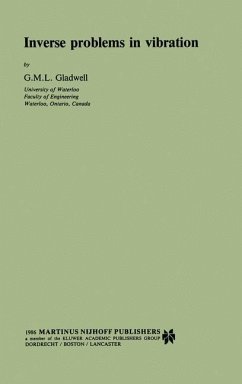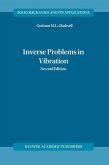`This book is a necessary addition to the library of engineers and mathematicians working in vibration theory.' -- Mathematical Reviews
The last thing one settles in writing a book is what one should put in first. Pascal's Pensees Classical vibration theory is concerned, in large part, with the infinitesimal (i. e. , linear) undamped free vibration of various discrete or continuous bodies. One of the basic problems in this theory is the determination of the natural frequencies (eigen frequencies or simply eigenvalues) and normal modes of the vibrating body. A body which is modelled as a discrete system' of rigid masses, rigid rods, massless springs, etc. , will be governed by an ordinary matrix differential equation in time t. It will have a finite number of eigenvalues, and the normal modes will be vectors, called eigenvectors. A body which is modelled as a continuous system will be governed by a partial differential equation in time and one or more spatial variables. It will have an infinite number of eigenvalues, and the normal modes will be functions (eigen functions) of the space variables. In the context ofthis classical theory, inverse problems are concerned with the construction of a model of a given type; e. g. , a mass-spring system, a string, etc. , which has given eigenvalues and/or eigenvectors or eigenfunctions; i. e. , given spec tral data. In general, if some such spectral data is given, there can be no system, a unique system, or many systems, having these properties.
The last thing one settles in writing a book is what one should put in first. Pascal's Pensees Classical vibration theory is concerned, in large part, with the infinitesimal (i. e. , linear) undamped free vibration of various discrete or continuous bodies. One of the basic problems in this theory is the determination of the natural frequencies (eigen frequencies or simply eigenvalues) and normal modes of the vibrating body. A body which is modelled as a discrete system' of rigid masses, rigid rods, massless springs, etc. , will be governed by an ordinary matrix differential equation in time t. It will have a finite number of eigenvalues, and the normal modes will be vectors, called eigenvectors. A body which is modelled as a continuous system will be governed by a partial differential equation in time and one or more spatial variables. It will have an infinite number of eigenvalues, and the normal modes will be functions (eigen functions) of the space variables. In the context ofthis classical theory, inverse problems are concerned with the construction of a model of a given type; e. g. , a mass-spring system, a string, etc. , which has given eigenvalues and/or eigenvectors or eigenfunctions; i. e. , given spec tral data. In general, if some such spectral data is given, there can be no system, a unique system, or many systems, having these properties.









